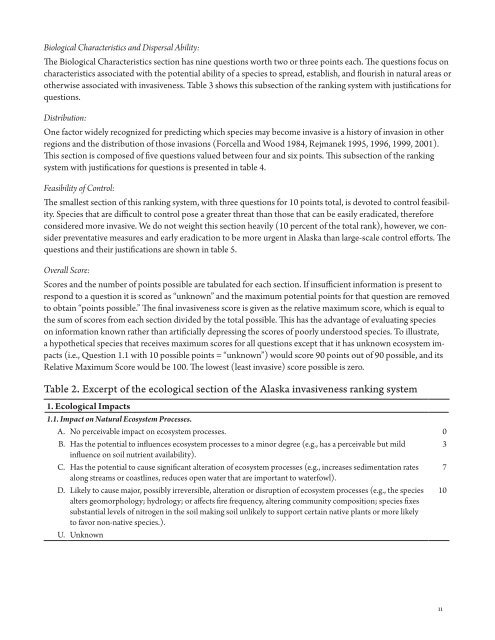Invasiveness Ranking System for Non-Native Plants of Alaska
Invasiveness Ranking System for Non-Native Plants of Alaska
Invasiveness Ranking System for Non-Native Plants of Alaska
Create successful ePaper yourself
Turn your PDF publications into a flip-book with our unique Google optimized e-Paper software.
Biological Characteristics and Dispersal Ability:The Biological Characteristics section has nine questions worth two or three points each. The questions focus oncharacteristics associated with the potential ability <strong>of</strong> a species to spread, establish, and flourish in natural areas orotherwise associated with invasiveness. Table 3 shows this subsection <strong>of</strong> the ranking system with justifications <strong>for</strong>questions.Distribution:One factor widely recognized <strong>for</strong> predicting which species may become invasive is a history <strong>of</strong> invasion in otherregions and the distribution <strong>of</strong> those invasions (Forcella and Wood 1984, Rejmanek 1995, 1996, 1999, 2001).This section is composed <strong>of</strong> five questions valued between four and six points. This subsection <strong>of</strong> the rankingsystem with justifications <strong>for</strong> questions is presented in table 4.Feasibility <strong>of</strong> Control:The smallest section <strong>of</strong> this ranking system, with three questions <strong>for</strong> 10 points total, is devoted to control feasibility.Species that are difficult to control pose a greater threat than those that can be easily eradicated, there<strong>for</strong>econsidered more invasive. We do not weight this section heavily (10 percent <strong>of</strong> the total rank), however, we considerpreventative measures and early eradication to be more urgent in <strong>Alaska</strong> than large-scale control ef<strong>for</strong>ts. Thequestions and their justifications are shown in table 5.Overall Score:Scores and the number <strong>of</strong> points possible are tabulated <strong>for</strong> each section. If insufficient in<strong>for</strong>mation is present torespond to a question it is scored as “unknown” and the maximum potential points <strong>for</strong> that question are removedto obtain “points possible.” The final invasiveness score is given as the relative maximum score, which is equal tothe sum <strong>of</strong> scores from each section divided by the total possible. This has the advantage <strong>of</strong> evaluating specieson in<strong>for</strong>mation known rather than artificially depressing the scores <strong>of</strong> poorly understood species. To illustrate,a hypothetical species that receives maximum scores <strong>for</strong> all questions except that it has unknown ecosystem impacts(i.e., Question 1.1 with 10 possible points = “unknown”) would score 90 points out <strong>of</strong> 90 possible, and itsRelative Maximum Score would be 100. The lowest (least invasive) score possible is zero.Table 2. Excerpt <strong>of</strong> the ecological section <strong>of</strong> the <strong>Alaska</strong> invasiveness ranking system1. Ecological Impacts1.1. Impact on Natural Ecosystem Processes.A. No perceivable impact on ecosystem processes. 0B. Has the potential to influences ecosystem processes to a minor degree (e.g., has a perceivable but mild3influence on soil nutrient availability).C. Has the potential to cause significant alteration <strong>of</strong> ecosystem processes (e.g., increases sedimentation rates 7along streams or coastlines, reduces open water that are important to waterfowl).D. Likely to cause major, possibly irreversible, alteration or disruption <strong>of</strong> ecosystem processes (e.g., the species 10alters geomorphology; hydrology; or affects fire frequency, altering community composition; species fixessubstantial levels <strong>of</strong> nitrogen in the soil making soil unlikely to support certain native plants or more likelyto favor non-native species.).U. Unknown11
















